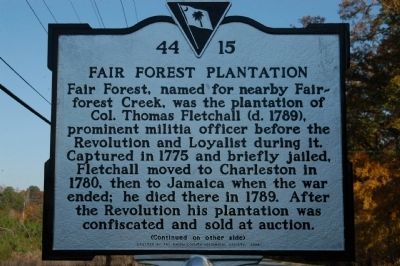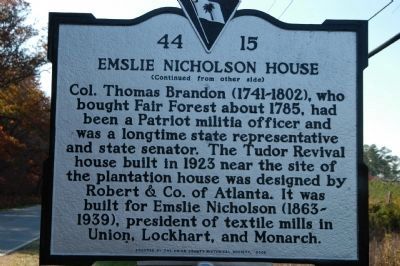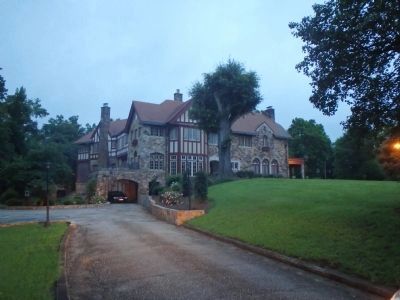Union in Union County, South Carolina — The American South (South Atlantic)
Fair Forest Plantation / Emslie Nicholson House
Erected 2008 by Union County Historical Society. (Marker Number 44-15.)
Topics and series. This historical marker is listed in these topic lists: Notable Buildings • Notable Places • Patriots & Patriotism • War, US Revolutionary. In addition, it is included in the South Carolina, Union County Historical Society series list. A significant historical year for this entry is 1775.
Location. 34° 40.883′ N, 81° 41.317′ W. Marker is in Union, South Carolina, in Union County. Marker is on Cross Keys Highway (State Highway 49) half a mile west of Riley Road, on the right when traveling west. Touch for map. Marker is in this post office area: Union SC 29379, United States of America. Touch for directions.
Other nearby markers. At least 10 other markers are within 5 miles of this marker, measured as the crow flies. Fairforest Meeting (approx. 1.2 miles away); Some Gave All (approx. 3 miles away); Union County Jail (approx. 4.3 miles away); Union Community Hospital (approx. 4.3 miles away); Union County Lynchings of 1871 (approx. 4.3 miles away); Reconstruction Era Lynchings in Union County / Union County Jail Raid Massacre (approx. 4.3 miles away); Lynching in America / Lynching in Union County after 1877 (approx. 4.3 miles away); John Pratt (approx. 4.3 miles away); Union Mill (approx. 4.3 miles away); Union County Confederate Monument (approx. 4.3 miles away). Touch for a list and map of all markers in Union.
Also see . . .
1. Biographical Sketch of Colonel Thomas Fletchall (1725-1789). Based on the limited official records that have survived, it appears that Colonel Thomas Fletchall was originally a native of Maryland, the son of Thomas (known as "Poor Thomas" by Fletchall family genealogists) and Elizabeth Fletchall. (Submitted on November 11, 2008, by Brian Scott of Anderson, South Carolina.)
2. Biographical Sketch of Thomas Brandon (1741-1802). The Scotch-Irish Brandon family, originally from Pennsylvania, settled in the Brown's Creek region of SC in the mid-1750's. (Submitted on November 11, 2008, by Brian Scott of Anderson, South Carolina.)
3. Fair Forest Plantation - Union County. Location – Fairforest Creek (a branch of the Tyger River), Ninety Six District, Union County. (Submitted on March 11, 2009, by Brian Scott of Anderson, South Carolina.)
Additional commentary.
1. About Col. Thomas Fletchall
It only required a leader of some military standing to organize a strong support for the royal cause in the up-country; and he was found. Thomas Fletchall, who resided at Fairforest, now Union County, was colonel of the regiment assigned to that section and was already under the suspicion of the Council of Safety. In reply to a letter written to ascertain his sentiments he plainly said that he was opposed to the Provincial Association.
Colonel Fletchall soon received an accession to the king's troops of upper Carolina, through the desertion of Moses Kirkland from the revolutionary cause. With Capt. John Caldwell, he had occupied Fort Charlotte on the Savannah River, so as to be in position to meet any Indian outbreak from that quarter. Their superior, Major Mayson, had brought some powder and lead from that fort to Ninety Six court house, in what is now the eastern part of Greenwood County. The munitions were in charge of Kirkland's troops, the commander of whom thought he saw a chance to join the stronger cause in the up-country and at the same time injure his military rival, Major Mayson. He therefore notified Colonel Fletchall, who was then holding a general muster of his regiment on the Enoree River, that any force he might send to take the power and lead would meet with no opposition. Fletchall took the precaution to send the officer of another regiment with Robert and Patrick Cunningham, well known in the Ninety Six district, the force dispatched consisting of 200 horses. The ammunition was quietly surrendered, and two companies of the revolutionary troops (including Kirkland's command) went over to the King's Own. The entire force numbering, it is said, 1,500 men, then formally subscribed to an agreement pledging loyalty to the king. A correspondence was opened between Colonel Fletchall and Lord William Campbell, and it seemed, for a time, as though all of upper Carolina was massed against the Provincial Congress and the principles for which it stood. McCrady suggests that had the royal governor acted boldly at this crisis, the independent movement in South Carolina might have been thwarted. (Source: History of South Carolina by Yates Snowden, pg. 320.)
— Submitted March 11, 2009, by Brian Scott of Anderson, South Carolina.
2. About Emslie Nicholson
Nicholson, Emslie, president of the Nicholson Bank and Trust company, president of the Excelsior Knitting mills, president of the People's Building and Loan association, president of the Bank of Jonesville, South Carolina, banker and manufacturer of Union, Union county, South Carolina, was born in the town where he still resides (Ed. Note: This was written in 1908.) and with all whose interests he is so prominently identified, on the 14th of March, 1863. His father, William A. Nicholson, was a banker of integrity and of activity and industry, whose interest in business affairs led to his election as a member of the state constitutional convention. He was born in Aberdeen Scotland; his wife, Mrs. Rebecca E. Nicholson, was born in London, England, and her son speaks of her as 'a devoted Christian mother, whose influence over his life has been strong and good."
His early life was passed in the village of Union. He had excellent health; and, while fond of out-of-door sports, he found keen delight in reading. He attended the local schools, and in particular at the Bingham school he completed his preparation for a college course. Attending Davidson college, he was graduated with the degree of B.S. in 1882. His own personal choice, as well as the choice of his father, William A. Nicholson, in 1882. His own personal choice, as well as the choice of his father, led to his beginning active life at once in the banking office of his father, William A. Nicholson, in 1882. His interest in people and his public-spirited attention to the property interests and the needs and wishes of his father, as well as to the social and commercial prosperity of his town, led to his becoming identified, while still a comparatively young man, with several of the leading commercial and manufacturing companies of his part of the state.
Besides the important companies named above, of which he is president, Mr. Nicholson is a director of the Monarch Cotton mills, a director of the Union-Buffalo Mills company, and a director in the National Loan and Exchange bank of Columbia, as well as president of the Bank of Jonesville, South Carolina.
While he is allied with the Democratic party, he has not sought or held public office.
On the 17th of September, 1889. he married Miss Kathleen Gray Murphy, daughter of Doctor John Murphy of Durant, Mississippi. They have had two children, both of whom are living in 1907. (Source: Men of Mark in South Carolina by James Calvin Hemphill, pg. 338.)
— Submitted March 11, 2009, by Brian Scott of Anderson, South Carolina.
Credits. This page was last revised on December 9, 2021. It was originally submitted on November 7, 2008, by Michael Sean Nix of Spartanburg, South Carolina. This page has been viewed 3,843 times since then and 149 times this year. Photos: 1, 2. submitted on November 7, 2008, by Michael Sean Nix of Spartanburg, South Carolina. 3. submitted on July 14, 2013, by Chad Comer of Gamaliel, Kentucky. • Kevin W. was the editor who published this page.


